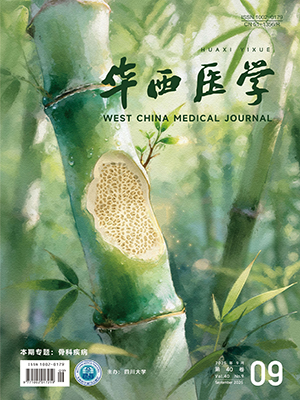【摘要】 目的 观察透明质酸锌凝胶治疗糖尿病足创面的疗效。 方法 2009年6月—2010年6月收治60例创面面积≤6 cm2的糖尿病足患者,其中男41例,女19例;年龄 49~80岁,平均58岁。糖尿病病程4~20年,糖尿病足病程2~12周。按照糖尿病足Wagner分级标准进行分级为Ⅰ、Ⅱ、Ⅲ级(每级各20例)。将患者随机分为治疗组和对照组,每组30例,每级各10例。两组患者性别、年龄、病程及创面比较差异均无统计学意义(P gt;0.05),具有可比性。两组患者均常规给予胰岛素或降糖药控制血糖,并同时给予抗炎、改善微循环及营养支持治疗。处理上治疗组加用透明质酸锌凝胶,对照组仅常规换药,治疗后4、8周观察两组创面愈合情况。 结果 治疗组8周时治愈率为53.3%,总有效率为96.7%;对照组治愈率为30.0%,总有效率为60.0%;两组总有效率比较差异有统计学意义(P lt;0.05)。治疗组对于Ⅱ、Ⅲ级创面的治愈率和有效率均明显优于对照组(P lt;0.01)。治疗组创面愈合时间为(23.25±8.52) d,对照组为(29.16±9.20) d,差异有统计学意义(P lt;0.05)。两组治疗后细菌培养结果无明显差异。 结论 透明质酸锌凝胶制剂应用于糖尿病足的创面治疗,能起到保护创面和促进创面愈合的作用,为治疗糖尿病足创面提供了一种新的方法。
【Abstract】 Objective To explore the curative effect of zinc hyaluronate in the treatment of diabetic foot wound. Methods Sixty patients with a diabetic foot wound area ≤6 cm2 were treated in our hospital from June 2009 to June 2010. There were 41 males and 19 females with their ages ranged from 49 to 80 years old, averaging at 58. The course of diabetes ranged from 4 to 20 years, and diabetic foot 2 to 12 weeks. According to diabetic foot Wagner grading standards, the patients were classified as grade Ⅰ, Ⅱ and Ⅲ (with 20 patients for each grade). They were randomly divided into the treatment group and the control group with 30 patients in each group and for both groups, there were 10 patients for each Wagner grade. There were no statistically significant differences between the two groups of patients in gender, age, duration of the disease course, and wound area (P gt;0.05) so that they were comparable. All patients were routinely offered with insulin or other medicine to control blood sugar level, and at the same time they accepted anti-inflammatory, microcirculation improving and nutrition supporting treatments. Zinc hyaluronate was added to the treatment of the patients in the treatment group, while the control group underwent conventional treatment. Wound healing condition was observed 4 and 8 weeks after the beginning of the treatment. Results At week eight, the cure rate for the treatment group was 53.3%, and the total effective rate was 96.7%; the two numbers for the control group were respectively 30.0% and 60.0%. There was a significant difference between the two groups in the total effectiveness (P lt;0.05). The cure rate and total effective rate for grade Ⅱ and Ⅲ wound in the treatment group were better than those in the control group (P lt;0.01). Coagulant time for the treatment group and the control group was respectively (23.25±8.52) days and (29.16±9.20) days with a significant difference (P lt;0.05). No statistical difference was found in the bacteria cultures between the two groups after treatment. Conclusions Using zinc hyaluronate in diabetic foot treatment can obviously protect the wound and promote wound healing. It is a good choice for diabetic foot wound healing.
Citation: LI Wei,ZHANG Bing,GAO Bing. Clinical Observation of Zinc Hyaluronate in the Treatment of Diabetic Foot Wound. West China Medical Journal, 2011, 26(6): 845-847. doi: Copy
Copyright © the editorial department of West China Medical Journal of West China Medical Publisher. All rights reserved




